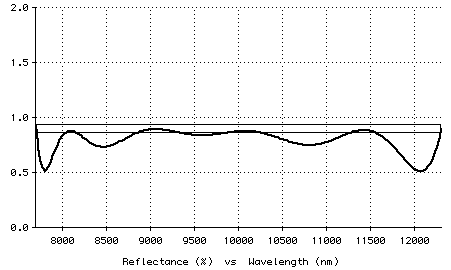Growing an Antireflection Coating
For this design, we require an AR coating on bulk germanium (index 4.0, denoted by G) that reduces the reflectance to less than 1% for the wavelength range 7700 nm to 12300 nm. The coating uses layers composed of Ge (index 4.2, denoted by H) and ZnS (index 2.2, denoted by L). All of these materials are available in the demo version of TFCalc.
Start with an initial design consisting of a single layer of L about 2300 nm thick (2 QWOTs at the reference wavelength of 10000 nm), we use optimization to design the coating. One continuous optimization target is used:
R < 0.9 from 7700 to 12300 nm
We use 0.9% so that we can make some manual adjustments and still meet the 1% target. To make the design as flat as possible, power=16 is used in the optimization process. We use a maximum of 1000 iterations and set the error tolerance to 1.0E-8. We use the needle and tunneling options with a maximum total thickness of 10000 nm. In less than a minute, TFCalc finds a 15-layer design. Removing one very thin layer and reoptimizing without needle optimization, we obtain a 13-layer design whose performance is displayed here.

L 157.14
H 285.97
L 563.34
H 84.60
L 1827.50
H 81.75
L 2590.54
H 1142.59
L 1234.92
H 131.55
L 457.49
H 629.03
L 1076.97
Download Design
You may download the initial design and watch how TFCalc optimizes it. Either the demo or real version of TFCalc may be used. Click here for the Windows file. Be sure to save it with extension ".TFD".